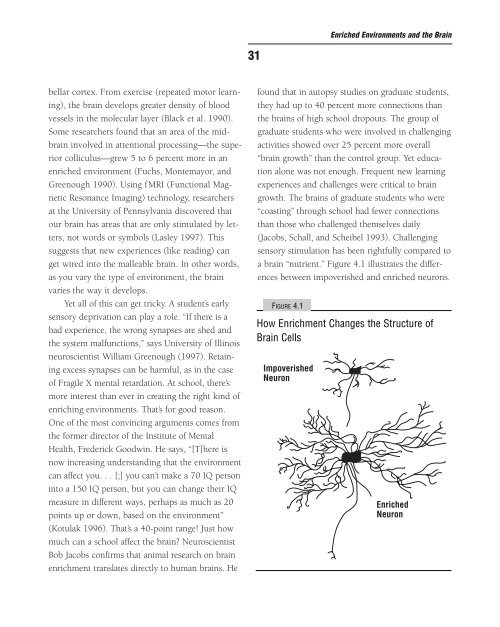Create successful ePaper yourself
Turn your PDF publications into a flip-book with our unique Google optimized e-Paper software.
ellar cortex. From exercise (repeated motor learn<strong>in</strong>g),<br />
<strong>the</strong> bra<strong>in</strong> develops greater density of blood<br />
vessels <strong>in</strong> <strong>the</strong> molecular layer (Black et al. 1990).<br />
Some researchers found that an area of <strong>the</strong> midbra<strong>in</strong><br />
<strong>in</strong>volved <strong>in</strong> attentional process<strong>in</strong>g—<strong>the</strong> superior<br />
colliculus—grew 5 to 6 percent more <strong>in</strong> an<br />
enriched environment (Fuchs, Montemayor, and<br />
Greenough 1990). Us<strong>in</strong>g fMRI (Functional Magnetic<br />
Resonance Imag<strong>in</strong>g) technology, researchers<br />
at <strong>the</strong> University of Pennsylvania discovered that<br />
our bra<strong>in</strong> has areas that are only stimulated by letters,<br />
not words or symbols (Lasley 1997). This<br />
suggests that new experiences (like read<strong>in</strong>g) can<br />
get wired <strong>in</strong>to <strong>the</strong> malleable bra<strong>in</strong>. In o<strong>the</strong>r words,<br />
as you vary <strong>the</strong> type of environment, <strong>the</strong> bra<strong>in</strong><br />
varies <strong>the</strong> way it develops.<br />
Yet all of this can get tricky. A student’s early<br />
sensory deprivation can play a role. “If <strong>the</strong>re is a<br />
bad experience, <strong>the</strong> wrong synapses are shed and<br />
<strong>the</strong> system malfunctions,” says University of Ill<strong>in</strong>ois<br />
neuroscientist William Greenough (1997). Reta<strong>in</strong><strong>in</strong>g<br />
excess synapses can be harmful, as <strong>in</strong> <strong>the</strong> case<br />
of Fragile X mental retardation. At school, <strong>the</strong>re’s<br />
more <strong>in</strong>terest than ever <strong>in</strong> creat<strong>in</strong>g <strong>the</strong> right k<strong>in</strong>d of<br />
enrich<strong>in</strong>g environments. That’s for good reason.<br />
One of <strong>the</strong> most conv<strong>in</strong>c<strong>in</strong>g arguments comes from<br />
<strong>the</strong> former director of <strong>the</strong> Institute of Mental<br />
Health, Frederick Goodw<strong>in</strong>. He says, “[T]here is<br />
now <strong>in</strong>creas<strong>in</strong>g understand<strong>in</strong>g that <strong>the</strong> environment<br />
can affect you. . . [;] you can’t make a 70 IQ person<br />
<strong>in</strong>to a 150 IQ person, but you can change <strong>the</strong>ir IQ<br />
measure <strong>in</strong> different ways, perhaps as much as 20<br />
po<strong>in</strong>ts up or down, based on <strong>the</strong> environment”<br />
(Kotulak 1996). That’s a 40-po<strong>in</strong>t range! Just how<br />
much can a school affect <strong>the</strong> bra<strong>in</strong>? Neuroscientist<br />
Bob Jacobs confirms that animal research on bra<strong>in</strong><br />
enrichment translates directly to human bra<strong>in</strong>s. He<br />
31<br />
Enriched Environments and <strong>the</strong> <strong>Bra<strong>in</strong></strong><br />
found that <strong>in</strong> autopsy studies on graduate students,<br />
<strong>the</strong>y had up to 40 percent more connections than<br />
<strong>the</strong> bra<strong>in</strong>s of high school dropouts. The group of<br />
graduate students who were <strong>in</strong>volved <strong>in</strong> challeng<strong>in</strong>g<br />
activities showed over 25 percent more overall<br />
“bra<strong>in</strong> growth” than <strong>the</strong> control group. Yet education<br />
alone was not enough. Frequent new learn<strong>in</strong>g<br />
experiences and challenges were critical to bra<strong>in</strong><br />
growth. The bra<strong>in</strong>s of graduate students who were<br />
“coast<strong>in</strong>g” through school had fewer connections<br />
than those who challenged <strong>the</strong>mselves daily<br />
(Jacobs, Schall, and Scheibel 1993). Challeng<strong>in</strong>g<br />
sensory stimulation has been rightfully compared to<br />
a bra<strong>in</strong> “nutrient.” Figure 4.1 illustrates <strong>the</strong> differences<br />
between impoverished and enriched neurons.<br />
FIGURE 4.1<br />
How Enrichment Changes <strong>the</strong> Structure of<br />
<strong>Bra<strong>in</strong></strong> Cells<br />
Impoverished<br />
Neuron<br />
Enriched<br />
Neuron



